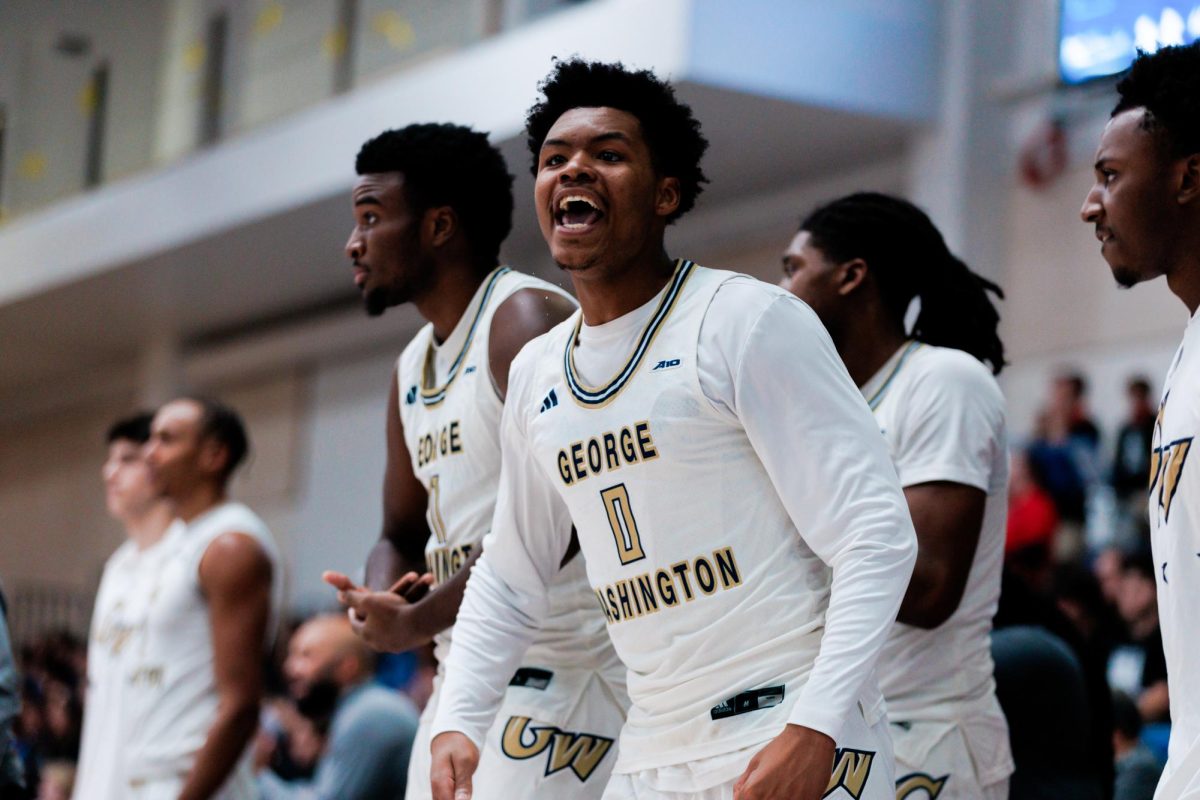
University President Steven Knapp’s office doesn’t hold much to suggest he is the chair of the Atlantic 10 Council of Presidents, a body made up of the leaders of the conference’s 14 member universities.
Bookcases line the walls of his Rice Hall office, with titles like “Anna Karenina” and “Inferno” peeking off the shelves. Dozens of mementos, but nothing to suggest that Knapp oversees the highest-ranking committee in the conference’s governance structure, except a single pom pom and a picture of him at Nationals Park.
Appointed at the beginning of the 2012-13 season, Knapp chairs the biannual meetings of the council. Knapp makes announcements for the league, and he regularly speaks one-on-one with A-10 Commissioner Bernadette McGlade.
“At the end of the day, the final decision as it regards to the constitution and bylaws of the A-10, those decisions are made by the 14 presidents of the 14 member institutions,” McGlade said in an interview last month.
The council approves the conference’s operating budget and has made changes to schedules and championships, including expanding the A-10 women’s basketball season from 14 to 16 games beginning in 2013-14. It also created the policy that if a program is ineligible for an NCAA tournament because of an Academic Progress Rate penalty, it will also be ineligible for A-10 championships.
“I think by and large [the A-10 is] pretty much aligned, and one of the good things about our conference is that everyone in the conference is strongly committed to the ideal of the student athlete,” Knapp said in an interview last week.
When the council next meets in November, the presidents will likely discuss the legislation that the power five “equity” conferences passed this summer, which is expected to increase benefits for student athletes.

In a time of sweeping changes in the NCAA, McGlade said she is glad Knapp will guide the A-10 council.
“He has been invaluable in that role in terms of his vision and leadership and really keeping our entire presidents council laser focused on these important initiatives that are really affecting the future of intercollegiate programs,” McGlade said.
That focus is coming from a college president who does not have a background in sports. Knapp said he was “mainly a musician” in high school, though he did wrestle for one year.
Knapp said he was on the team because he was in the lowest weight class. Although he was a beginner, he said he could earn points for his team if he won by default when the opposing team did not have a member as small as he was.
“I was sort of cannon fodder out there because I had no experience, and if they did have somebody that size then I got creamed because I was completely new to it,” Knapp said.
Knapp, who came to GW in 2007, said it took a crash course in A-10 politics as a member of the council’s membership committee to make him more “immersed” in the world of college sports, especially during years when conference realignment swept over the NCAA. Creating the University’s Athletic Strategic Plan with the Board of Trustees also raised his awareness of the issues facing student-athletes.
Knapp was elected to replace the president of former A-10 member Xavier University, Rev. Michael Graham, who stepped down after seven years as chair. Since 2010, the conference has seen the departures of Butler, Xavier, Charlotte and Temple and the addition of George Mason, VCU and most recently Davidson, which officially became a member in July.
The loss of high-performing schools was expected to weaken the A-10. But last year, it saw six teams receive bids to the men’s basketball NCAA tournament, the same number as Power Five conferences like the Atlantic Coast Conference, Big Ten and Pac-12. This season, a conference-record 96 men’s basketball games will be televised.
The A-10 has managed to maintain its success, even after it was tagged as a league on the losing end of realignment. In some cases, teams that have switched conferences to pursue larger television revenues have helped GW and the A-10.
Maryland, formerly of the ACC, pulled in $32 million by joining the Big Ten for the 2014 season – a payout that will jump to $43 million in 2017 after the conference renews its TV contract. Since UMD’s departure, Virginia has made home-and-home agreements with GW men’s basketball over the next two years, allowing the Cavaliers to continue to tap into the D.C. media market.
Knapp said the situation would be different in a league that had “huge money-making football programs” like the Big Ten.

He said the A-10 looks at all potential new members and determines whether the academics and values of the athletic program meet league standards. He seeks the same qualities in athletics staff, which led him to hiring Athletic director Patrick Nero, who Knapp said shares his academic priorities. GW student athletes earned an all-time high 3.22 cumulative grade point average last spring.
“I think it helps that we’re remaining true to our focus on basketball across the conference and in academics,” Knapp said.
Knapp said A-10 membership appears stable right now, though the membership committee monitors schools that it thinks could be good additions at all times.
Still, not all is harmonious on the council. Knapp said as possible changes in NCAA bylaws come under consideration, he does not want to see college athletics move toward professionalization.
“That would mean that our student athletes would have a harder time functioning as student athletes, and that’s the bottom line for us,” Knapp said.
Though not every issue is settled, the league’s unlikely leader said he is ready to face dynamic shifts in the collegiate landscape after his unorthodox sports education. It may not be what everyone is doing, but Knapp said he is optimistic that upholding the A-10’s standards will pay off.
“I think that kind of integrity is good for morale,” Knapp said.







